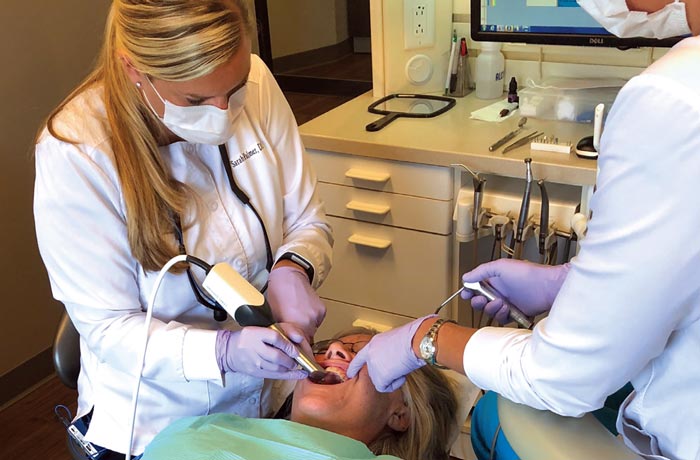Learn the Top Dentist Eugene Oregon Citizens Recommend for Exceptional Treatment
Learn the Top Dentist Eugene Oregon Citizens Recommend for Exceptional Treatment
Blog Article
Check Out the Variety Of Dental Issues Dentists Frequently Take Care Of
Dentists are entrusted with dealing with a wide range of oral issues, each needing specialized expertise and techniques. From the common trouble of cavities triggered by microbial activity to the much more dangerous development of periodontal disease, oral experts should be experienced at very early detection and intervention. Tooth level of sensitivity, often arising from worn enamel, adds one more layer of complexity, while the very early identification of oral cancer cells can be life-saving. Additionally, misaligned bites demand tailored therapy plans to enhance both performance and looks. What details techniques do dentists employ to handle these diverse difficulties properly?

Cavities and Dental Caries
While preserving optimal oral hygiene is crucial, tooth cavities and dental caries continue to be common problems that dental experts frequently deal with. Dental caries, also called tooth decays, are brought on by the demineralization of tooth enamel because of acid-producing microorganisms in the mouth. These bacteria flourish on sugars and starches from food and drinks, developing a cycle of acid strikes that gradually erode the enamel and dentin layers of teeth. If left unattended, cavities can lead to considerable oral complications, including infections and missing teeth.
To detect dental caries and tooth decay, dental professionals use a mix of visual examinations, dental X-rays, and in some cases laser fluorescence gadgets. For even more advanced degeneration, a dental professional may need to eliminate the endangered cells and restore the tooth with fillings made from materials such as composite resin, amalgam, or porcelain.
Safety nets are vital in combating cavities and dental cavity. Routine dental check-ups, appropriate cleaning and flossing strategies, and a balanced diet regimen low in sweet foods and beverages are basic practices that sustain dental health and decrease the threat of cavities.
Gum Condition
Periodontal condition, additionally called gum condition, is a significant dental health concern that impacts the tissues surrounding and sustaining the teeth. It begins with gingivitis, which is identified by red, puffy periodontals that might hemorrhage easily. If left without treatment, gingivitis can advance to periodontitis, a much more severe kind of periodontal condition that can bring about missing teeth and damages to the jawbone.
Periodontitis occurs when plaque, a sticky movie of microorganisms, solidifies right into tartar and builds up below the gum line. This causes the periodontals to retreat from the teeth, producing pockets that come to be contaminated. As the body's body immune system fights the germs, the bone and connective tissue that hold teeth in position are damaged down. The risk aspects for gum illness include poor oral hygiene, smoking cigarettes, diabetic issues, and genetic predisposition.

Tooth Level Of Sensitivity
Beyond gum tissue disease, one more common dental concern that people often run into is tooth sensitivity. Identified by a sharp, transient pain in action to stimulations such as hot, cool, wonderful, or acidic foods and drinks, tooth level of sensitivity can significantly influence a person's quality of life.
Additionally, oral treatments, fractured teeth, and gum tissue condition can reveal the dentin. To alleviate tooth level of sensitivity, dental professionals may recommend using Source tooth paste created for delicate teeth, fluoride treatments to strengthen enamel, or oral bonding to cover exposed dentin.

Oral Cancer
Oral cancer cells, a potentially life-threatening and serious condition, usually flies under the radar in regular dental care conversations. This kind of cancer can affect any kind of part of the oral cavity, including the lips, tongue, cheeks, flooring of the mouth, soft and difficult tastes, sinuses, and throat. Early discovery is vital for effective treatment, yet several instances are identified at advanced stages as a result of subtle first symptoms.
Dental practitioners play an essential duty in the very early detection of dental cancer. During regular examinations, they diligently analyze the oral tooth cavity for irregular sores, relentless sores, or unusual swellings. They may additionally utilize adjunctive testing devices such as special dyes or light resources to recognize dubious locations that are not noticeable to the nude eye.
Risk aspects for oral cancer cells include tobacco usage, extreme alcohol consumption, human papillomavirus (HPV) infection, and long term direct exposure to the sun. Patients are recommended to report any kind of consistent adjustments in their dental wellness, such as trouble ingesting, unusual blood loss, or feeling numb, to their dental professional right away.
Misaligned Bites
Misaligned bites, additionally referred important link to as malocclusions, are a typical oral issue that can significantly influence both dental health and general top quality of life. These problems occur when the top and lower teeth do not straighten properly, resulting in problems in biting, chewing, and even talking. Malocclusions can be categorized into various types, consisting of overbites, underbites, crossbites, and open bites, each offering one-of-a-kind obstacles that need tailored treatment strategies.
The reasons for misaligned bites are diverse and can include hereditary variables, very early loss of main teeth, thumb sucking, and injuries to the jaw. Symptoms commonly include discomfort or pain in the jaw, constant biting of the inner cheeks, and an increased risk of dental caries and gum tissue condition as a result of problem in keeping dental hygiene.
Dentists and orthodontists utilize a range of treatments to resolve misaligned attacks, from clear aligners and conventional braces to much more sophisticated surgeries in severe instances. Early diagnosis and therapy are important to stop problems such as temporomandibular joint check this site out (TMJ) conditions and abnormal wear on teeth. Through extensive evaluation and individualized therapy strategies, dental specialists play a critical duty in dealing with malocclusions and enhancing clients' dental feature and aesthetics.
Conclusion
Dental caries and tooth degeneration result from microbial task that jeopardizes tooth enamel, while periodontal condition can intensify from gingivitis to extreme periodontal conditions. Tooth sensitivity includes discomfort from thermal stimulations, demanding details care.
To identify cavities and tooth decay, dental practitioners utilize a mix of visual examinations, dental X-rays, and in some cases laser fluorescence devices.Beyond periodontal condition, another usual dental concern that individuals often come across is tooth level of sensitivity. Furthermore, oral treatments, fractured teeth, and periodontal disease can subject the dentin. To mitigate tooth level of sensitivity, dental experts may suggest using tooth paste developed for delicate teeth, fluoride treatments to enhance enamel, or oral bonding to cover subjected dentin - dentist eugene oregon. Cavities and tooth decay result from microbial activity that compromises tooth enamel, while gum tissue condition can intensify from gingivitis to severe gum problems
Report this page